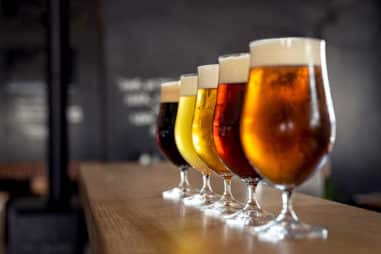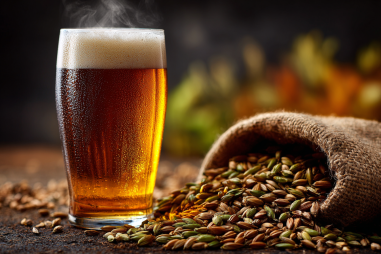So If you happen to go to Belgium for your vacation, you should try their whitish foamy beer. You will be pleasantly surprised to experience pops of fruity flavors. The fruitiness coming from oranges and coriander. And when you take a sip, the mouthfeel will be smooth and creamy.
If you want to brew or simply want to know more about Witbier, this article will get you primed on the subject.
Why is it Called Witbier?
It is called Witbier by the Belgians mainly because the beer has a cloudy look to it. It would remind you of cream or haze.
You might not want to hear it but the clouds are from the effects of yeast on the ingredients. It makes a tasty beverage, mind you.
What Does Wit Mean in Belgian?
“Wit” translates to “white” in Belgian. It is referring to the visual of “white clouds” in the beer. This beer uses light-colored base malts that encourage whiteness. You should avoid darker base malts if you decide to blend your own.
Beyond the whitish haze of yeast, it has variations in hues and saturations of orange and yellow.
Are Witbier and Hefeweizen the Same?
Witbier and Hefeweizen are the same in certain aspects and different in others. They are the same in that they use wheat as one of the primary ingredients. You could even go as far as saying that they are a similar class of beer.
On the other side of the coin, their full ingredients roster and end results make them different.
What is the Difference Between Hefeweizen and Witbier?
Here are some parameters that make the difference:
- Color: Hefeweizen has darker color tones compared to Witbier’s pale yellow to gold.
- Distinct Ingredients: Hefeweizen is not spiced. Witbier use orange peels and coriander.
- Origin: Hefeweizen hails from Bavaria. Witbier is from Belgium.
- Yeast: The yeast strains used are different. The selected strains create the signature flavor profiles of the beers.
What Kind of Beer is a Witbier?
Witbier falls in the general classification of a Wheat Beer. By definition, Wheat Beers use wheat where another class of beers would use malted barley.
Is Witbier the Same as Wheat Beer?
Their similarity is a kind of parent-child relationship. You could look at Wheat Beer as the parent and Witbier as the child. The child inherits the same base wheat attributes from the parent. However, the child springs its own unique characteristics.
It sounds oddly unintuitive with “wit” sounding like “wheat.” But you could argue that the beer being white is from the interaction of the wheat and other ingredients.
What is in Witbier?
For Belgian authenticity, Witbier needs the signature ingredients of orange peels and coriander. Without those two key pieces, your beer cannot hope to claim the Witbier name.
Moreover, you need the perfect yeast to produce quality Witbier with a distinct haze.
Does Witbier Have Wheat?
With Witbier being the same as Wheat Beer, you would have around 50% wheat in your grains. The wheat can come in the form of raw wheat or flaked wheat.
Does Witbier Have Hops?
Historically, Witbier did not have hops in its recipe. Choice herbs and spices were used instead to temper the sweetness of the malt.
Upon the discovery of hops, the Witbier recipe eventually incorporated this new element. It added the distinct aroma and bitterness associated with beer.
How Much Orange Peel to Add in a Witbier?
The addition of orange peels by weight ranges from 0.5 to 2.0 ounces (14 to 57 grams) for a five-gallon batch. It even varies when it comes to the use of dried or fresh zest, and from using sweet or bitter oranges. The Curacao Orange is the common choice when it comes to bitter oranges.
If you are a Witbier initiate, you should start small and make tweaks in future attempts. Also, it is important to remember that the orange kick fades over time.
How Much Coriander to Add in a Witbier?
Fresh coriander is desirable in ranges of 0.5 to 1.0 ounces (14 to 28 grams) for a five-gallon batch.
A little goes a long way with this intense herb. You would not want to overpower the beer with coriander. You must ensure to crush the seeds to a fine consistency to get that uniform diffusion.
How Would You Describe a Witbier?
Visually, you could describe Witbier as waking up to a pale and misty day. The cloudy unfiltered beer is a dance of wheat and yeast. As the beer washes your palate and taste buds, you can feel the creaminess of clouds.
It is full of life from all the energetic bubbling. It is livelily carbonated such that it easily forms a thick head so take care when serving.
What Does Witbier Taste Like?
With Witbier, you will get a fruity experience from the spices. You will get a gentle mix of sweetness and zest that is reminiscent of clove and banana.
The oranges either provide a kick of citrus or a heightened orange flavor.
Not to mention that the wheat gives it a wash of bread and yeast flavors.
Is Witbier Malty?
Witbier is composed of variations of 50% malted and 50% unmalted grains. With that being said, Witbier has a subtle sweet maltiness to it.
Is Witbier an Ale or Lager?
Witbier fermentation temperatures work within the range of temperatures defined for Ales. Temperature ranges roughly define the difference of Ales from Lagers. Thus, you could say with a level of certainty that Witbier is an Ale.
Why is Witbier an Ale?
The yeasts used for Witbier work best when under the fermentation conditions of Ales. If you want to run the numbers, ales typically ferment in the temperature range of 15 to 24°C (60 to 75°F). And if you scan through a bunch of random Witbier recipes, you will find that the temperatures fit the scope.
Is Witbier a Hoppy?
Technically speaking, Witbier is not a Hoppy beer. Hoppy beers are designed to flaunt the hop flavor and aroma.
For Witbier, hops is not the star of the show. Rather, it works together with the herbs and spices to regulate the sweetness of the malt.
Is Witbier an IPA?
Since Witbier is not a hoppy beer, it follows that it is not an IPA. IPA is a hoppy beer because of its focus on a variety of hops in its blend.
Is Witbier a Sour?
Certain facts make Witbier not a Sour beer. Witbier does not use wild yeast strains and/or bacteria as Sour beer does. It also does not have the distinct tartness representative of Sours.
How to Serve Witbier?
You could traditionally serve Witbier in a tulip glass. Keeping the beer in a cool 40 to 45°F (4.5 to 7.0°C) is the ideal way to serve.
Before you start serving, roll the beer to engage the flavorful yeast. Get that carbonation going, and then pour the beer into your tulip glass.
Optionally, you could slice an orange of your preference to garnish the lip of the glass. And if you are looking for some extra punch, plop the orange slice in the beer.
How Do You Pour a Witbier?
Here is the common way for you to pour Witbier like a seasoned veteran:
- Hold your glass at a 45° Some folks almost hold it near horizontal. You can play with the angle with whatever works for you.
- Stick the bottle’s neck in the glass, slow and controlled.
- Tilt the bottle up, slow and steady.
- Pour out the top three-fourths of the beer, slowly. You know you are going too fast if you observe a foaming frenzy.
- Pull the bottle out carefully.
- Swirl the bottle a bit. Pick up all that good yeast and flavor.
- Pour the remainder a little faster to make around 1.5 inches of foam head.
- Leave a small volume to soften any hardened yeast.
- Give a little shake or swirl to loosen the yeast.
- Finish by pouring the final bits of yeast.
What Do You Eat with Witbier?
While enjoying your favorite blend of Witbier, you can try the following food:
- Cheese: Fresh goat cheeses with their tart flavor go well with the citrus of the beer. In addition, the earthiness of goat cheese pairs with the coriander’s nutty spiciness. Sipping the creamy beer enhances the texture of the cheese.
- Seafood: Bounty from the sea that works well with citrus and acidity match up with Witbier. You could think of sushi, mussels, oysters, and ceviche, to name a few.
- Salads: Salads with goat cheeses and/or citrusy dressings. They are great complements for the same reason as seafood.
Can I Brew Witbier?
Brewing Witbier is accessible even to novices. You can search in online retailers for Witbier Ingredient Kits and get started.
You should look for the kits that use extracts. That is unless you know what you are doing and want to grind and mash your own grains. The decoction mash process can be quite labor-intensive but very rewarding.
How Do You Make a Belgian Witbier?
Making Witbier differs depending on how easy or difficult the journey you want to take. The laborious would look like:
- Read: Always read the instruction manual before brewing. This is especially true when you are brewing your own blend or doing your own mashing.
- Sanitize Your Equipment: The equipment kits come with a disinfectant. Apply it on all your surfaces and tubes.
- Mash Grains: This process can get complicated so additional research is advised. But, basically, you would mash grains for 1.0 to 1.5 hours at 153°F (67.2°C).
- Sparging:
- Heat water in a kettle to 180°F (82.2°C).
- Sparge the mash in a separate container.
- Boiling / Brewing:
- Continue heating the wort until it reaches a rolling boil.
- Add in hops as dictated by the recipe.
- After 50 minutes, put in your coriander, orange peel, and other spices specified in the recipe.
- Boil up to 10 minutes more.
- Cooling:
- Quickly cool the wort to below 70°F (21.1° C). You can use a container filled with ice water or use a wort chiller.
- Fermenting:
- Transfer your wort into the fermentation vessel.
- Add water until you reach the prescribed gallonage.
- If you want to be precise, use a hydrometer for determining your beer’s initial alcohol by volume (ABV).
- Aerate your wort by rocking the container. Splashing is key here.
- Pitch your yeast into the fermenter.
- Seal the fermenter and leave it in a cool and dark place.
- Wait for one week. Use a hydrometer to measure ABV if it meets the recipe’s target.
- Wait for another week. Use a hydrometer to measure ABV if it meets the recipe’s target.
- Bottling:
- Sanitize your bottles and tubes.
- Stimulate carbonation with priming sugar and added yeast.
- Fill, cap, and store your bottles for around two weeks.
How Long to Ferment a Witbier?
You ferment Witbier for at least two weeks. Always make sure you check the hydrometer so you do not overdo it.
Some experts recommend transferring to a secondary fermentation vessel. This is to avoid the chance of getting off-flavors from sediment in the first vessel.
When to Bottle a Witbier?
As soon as fermentation ends signals the best time to bottle a Witbier. Rushing to bottle does not improve the flavor profile so it is best to exercise your patience. You can expect a reward of a great bottle conditioned taste and spirited carbonation.







